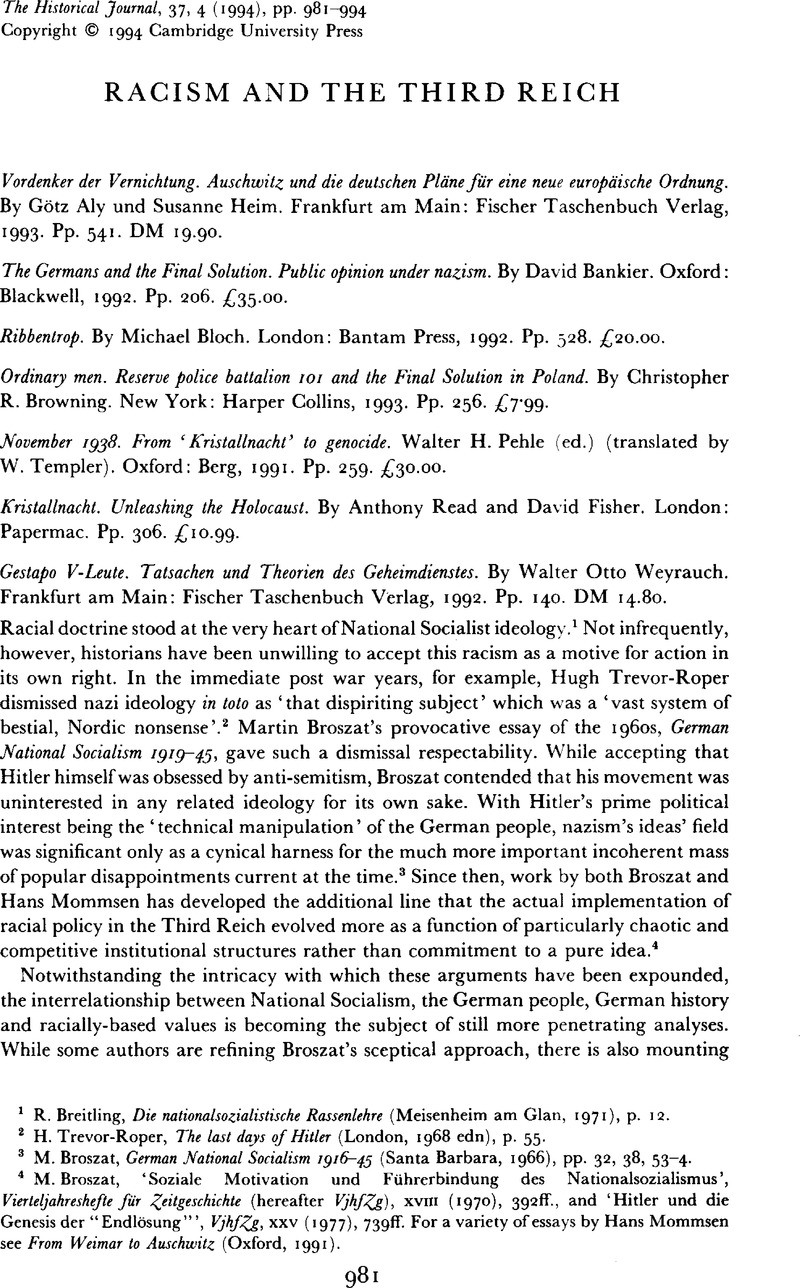No CrossRef data available.
Article contents
Racism and the Third Reich
Published online by Cambridge University Press: 11 February 2009
Abstract

- Type
- Review Articles
- Information
- Copyright
- Copyright © Cambridge University Press 1994
References
1 Breitling, R., Die nationalsozialistische Rassenlehre (Meisenheim am Glan, 1971), p. 12.Google Scholar
2 Trevor-Roper, H., The last days of Hitler (London, 1968 edn), p. 55.Google Scholar
3 Broszat, M., German National Socialism 1916–45 (Santa Barbara, 1966), pp. 32, 38, 53–4.Google Scholar
4 Broszat, M., ‘Soziale Motivation und Führerbindung des Nationalsozialismus’, Vierteljahreshefte für Zeitgeschichte (hereafter VjhfZg), XVIII (1970), 392ff.Google Scholar, and ‘Hitler und die Genesis der “Endlosung”’, VjhfZg, XXV (1977), 739ffGoogle Scholar. For a variety of essays by Mommsen, Hans see From Weimar to Auschwitz (Oxford, 1991).Google Scholar
5 See, for example, Breitman, R., The architect of genocide. Himmler and the Final Solution (London, 1991)Google Scholar, Burleigh, M. and Wippermann, W., The racial state. Germany 1933–1945 (Cambridge, 1991)Google Scholar, Graml, H., Antisemitism in the Third Reich (Oxford, 1992)Google Scholar and Housden, M., Helmut Nicolai and nazi ideology (London, 1992.CrossRefGoogle Scholar
6 The Economist, cited on the back of Read, A. and Fisher, D., Kristallnacht. Unleashing the Holocaust (London, 1991).Google Scholar
7 Read and Fisher, Kristallnacht, pp. 70–1.
8 For a good study of ‘Crystal Night’ see Graml, Antisemitism, ch. 1.
9 Read and Fisher, Kristallnacht, ch. 13.
10 Original version Der Judenpogrom. Von der ‘Reichskristallnacht’ zum Völkermord (Frankfurt am Main, 1988).
11 Benz, W., ‘The relapse into barbarism’, in Pehle, W. H. (ed.), November 1938. From ‘Kristallnacht’ to genocide (Oxford, 1991), ch. 1.Google Scholar
12 Zuelzer, W., ‘Recollections of a non-aryan emigrant from the Third Reich’, in Pehle, November 1938, p. 163.Google Scholar
13 Adam, U. D., ‘How spontaneous was the pogrom?’, in Pehle, November 1938, pp. 80–3.Google Scholar
14 Ibid. p. 34.
15 Barkai, A., ‘The fateful year 1938: the continuation and acceleration of plunder’, in Pehle, November 1938, p. 96.Google Scholar
16 Ibid. p. 121.
17 Graml, H., ‘The genesis of the Final Solution’, in Pehle, November 1938, p. 170.Google Scholar
18 Ibid. p. 175.
19 Mommsen, H., ‘What did the Germans know about the genocide of the Jews?’, in Pehle, November 1938, p. 219.Google Scholar
20 Bankier, D., The Germans and the Final Solution. Public opinion under nazism (Oxford, 1992), pp. 4–10. Sopade – the German socialist party in exile.Google Scholar
21 Ibid. pp. 23–4.
22 Ibid. p. 50.
23 Ibid. pp. 94, 121.
24 Ibid. p. 136.
25 Gellately, R., The Gestapo and German society. Enforcing racial policy 1933–45 (Oxford, 1990)CrossRefGoogle Scholar and especially the paper ‘Surveillance and disobedience: aspects of the political policing of nazi Germany’, in Nicosia, F. R. and Stokes, L. D. (eds.), Germans against nazism. Essays in honour of Peter Hoffmann. Nonconformity, opposition and resistance in the Third Reich (Oxford, 1990), pp. 15ff.Google Scholar
26 Weyrauch, W. O., Gestapo V-Leute. Tatsachen und Theorien des Geheimdienstes (Frankfurt am Main, 1992), p. 24.Google Scholar
27 Ibid. p. 12.
28 Browning, C. R., Ordinary men. Reserve police battalion 101 and the Final Solution in Poland (New York, 1993), pp. 83–4.Google Scholar
29 Ibid. p. XX.
30 Ibid. p. 189.
31 Ibid. pp. 47–8.
32 Ibid. p. 85.
33 Ibid. ch. 18.
34 Ibid. p. 73.
35 Ibid. pp. 74–5.
36 Aly, G. and Heim, S., Vordenker der Vernichtung. Auschwitz und die deutschen Pläne für eine neue europäische Ordnung (Frankfurt am Main, 1993), p. 453.Google Scholar
37 Ibid. pp. 14–15.
38 Ibid. p. 297.
39 Ibid. pp. 382–8.
40 Ibid. p. 14.
41 For studies of the Government-General which underline the competitive style of government that operated there see Browning, C. R., The path to genocide (Cambridge, 1992), chs. 1, 2 and 6Google Scholar, Housden, M., ‘Hans Frank – empire-builder in the East, 1939–41’, European History Quarterly, XXIV (1994)Google Scholar and to a lesser extent Breitman, Architect of genocide.
42 My own biography of Helmut Nicolai, Brown House and Reich interior ministry planner, shows particularly clearly the often complicated relationship between ideas and actions that existed in the Hitler state. The study deals predominantly with the party-state conflict of 1933–35. Housden, Helmut Nicolai, ch. 9 ‘The Nicolai Era’ and ch. 10 ‘Summing up’.
43 See Laux, E., ‘Führung und Verwaltung in der Rechtslehre des Nationalsozialismus’, in Rebentisch, D. and Teppe, K. (eds.) Verwaltung contra Menschenführung im Staat Hitlers (Gottingen, 1986), p. 46.Google Scholar
44 Bloch, M., Ribbentrop (London, 1992), p. 24, 203.Google Scholar
45 Ibid. p. 206.
46 Ibid. p. 297.
47 Ibid. pp. 354–5.
48 Ibid. p. 360.
49 Ibid. p. 374.
50 For a discussion of the Holocaust denial literature, see Vidal-Naquet, P., Assassins of memory. Essays on the denial of the Holocaust (Colombia, 1993).Google Scholar


